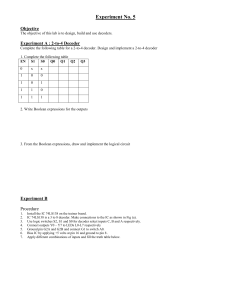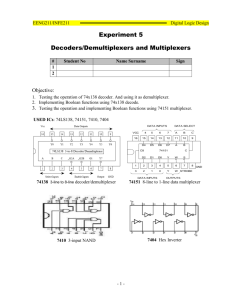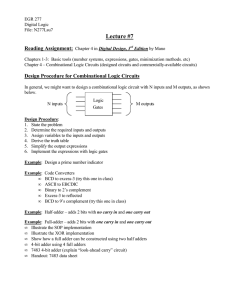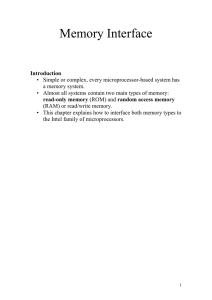EE121Lec05
advertisement
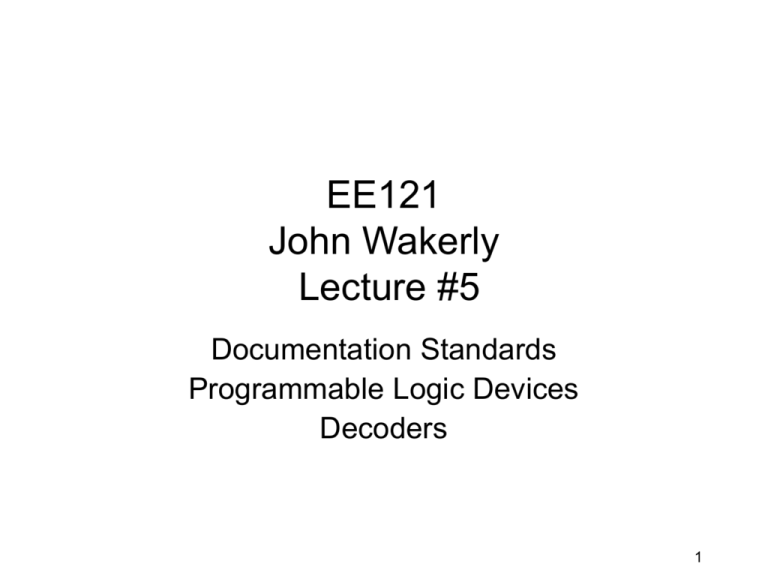
EE121 John Wakerly Lecture #5 Documentation Standards Programmable Logic Devices Decoders 1 Documentation Standards • Block diagrams – first step in hierarchical design • Schematic diagrams • HDL programs (ABEL, Verilog, VHDL) • Timing diagrams • Circuit descriptions 2 Block Diagram 3 Schematic diagrams • Details of component inputs, outputs, and interconnections • Reference designators • Pin numbers • Title blocks • Names for all signals • Page-to-page connectors 4 Example schematic 5 Flat schematic structure 6 Hierarchichal schematic structure 7 Other Documentation • Timing diagrams – Output from simulator – Specialized timing-diagram drawing tools • Circuit descriptions – Text (word processing) – E102E – Can be as big as a book (e.g., typical Cisco ASIC descriptions) – Typically incorporate other elements (block diagrams, timing diagrams, etc.) 8 Gate symbols 9 DeMorgan equivalent symbols Which symbol to use? Answer depends on signal names and active levels. 10 Signal names and active levels • Signal names are chosen to be descriptive. • Active levels -- HIGH or LOW – named condition or action occurs in either the HIGH or the LOW state, according to the active-level designation in the name. 11 Example HIGH when error occurs Logic Circuit ERROR OK_L LOW when error occurs Logic Circuit ERROR_L ERROR ERROR1_L 12 Programmable Logic Arrays (PLAs) • Any combinational logic function can be realized as a sum of products. • Idea: Build a large AND-OR array with lots of inputs and product terms, and programmable connections. – n inputs • AND gates have 2n inputs -- true and complement of each variable. – m outputs, driven by large OR gates • Each AND gate is programmably connected to each output’s OR gate. – p AND gates (p<<2n) 13 Example: 4x3 PLA, 6 product terms 14 Compact representation • Actually, closer to physical layout (“wired logic”). 15 Some product terms 16 PLA Electrical Design • See Section 5.3.5 -- wired-AND logic 17 Programmable Array Logic (PALs) • How beneficial is product sharing? – Not enough to justify the extra AND array • PALs ==> fixed OR array – Each AND gate is permanently connected to a certain OR gate. • Example: PAL16L8 18 • 10 primary inputs • 8 outputs, with 7 ANDs per output • 1 AND for 3-state enable • 6 outputs available as inputs – more inputs, at expense of outputs – two-pass logic, helper terms • Note inversion on outputs – output is complement of sum-of-products – newer PALs have selectable inversion 19 Designing with PALs • Compare number of inputs and outputs of the problem with available resources in the PAL. • Write equations for each output using ABEL. • Compile the ABEL program, determine whether minimimized equations fit in the available AND terms. • If no fit, try modifying equations or providing “helper” terms. • Lab #2 20 Decoders • General decoder structure • Typically n inputs, 2n outputs – 2-to-4, 3-to-8, 4-to-16, etc. 21 Binary 2-to-4 decoder Note “x” (don’t care) notation. 22 2-to-4-decoder logic diagram 23 MSI 2-to-4 decoder • Input buffering (less load) • NAND gates (faster) 24 Decoder Symbol 25 Complete 74x139 Decoder 26 More decoder symbols 27 3-to-8 decoder 28 74x138 3-to-8-decoder symbol 29 Decoder cascading 4-to-16 decoder 30 More cascading 5-to-32 decoder 31 ABEL / PAL Version of 74x138 32 ABEL decoder program (continued) 33 An easier way to decode 34 Decoder applications • Microprocessor memory systems – selecting different banks of memory • Microprocessor input/output systems – selecting different devices • Microprocessor instruction decoding – enabling different functional units • Memory chips – enabling different rows of memory depending on address • Lots of other applications 35 Next time • Encoders • Three-state devices • Multiplexers • XOR gates • Comparators • Adders 36
